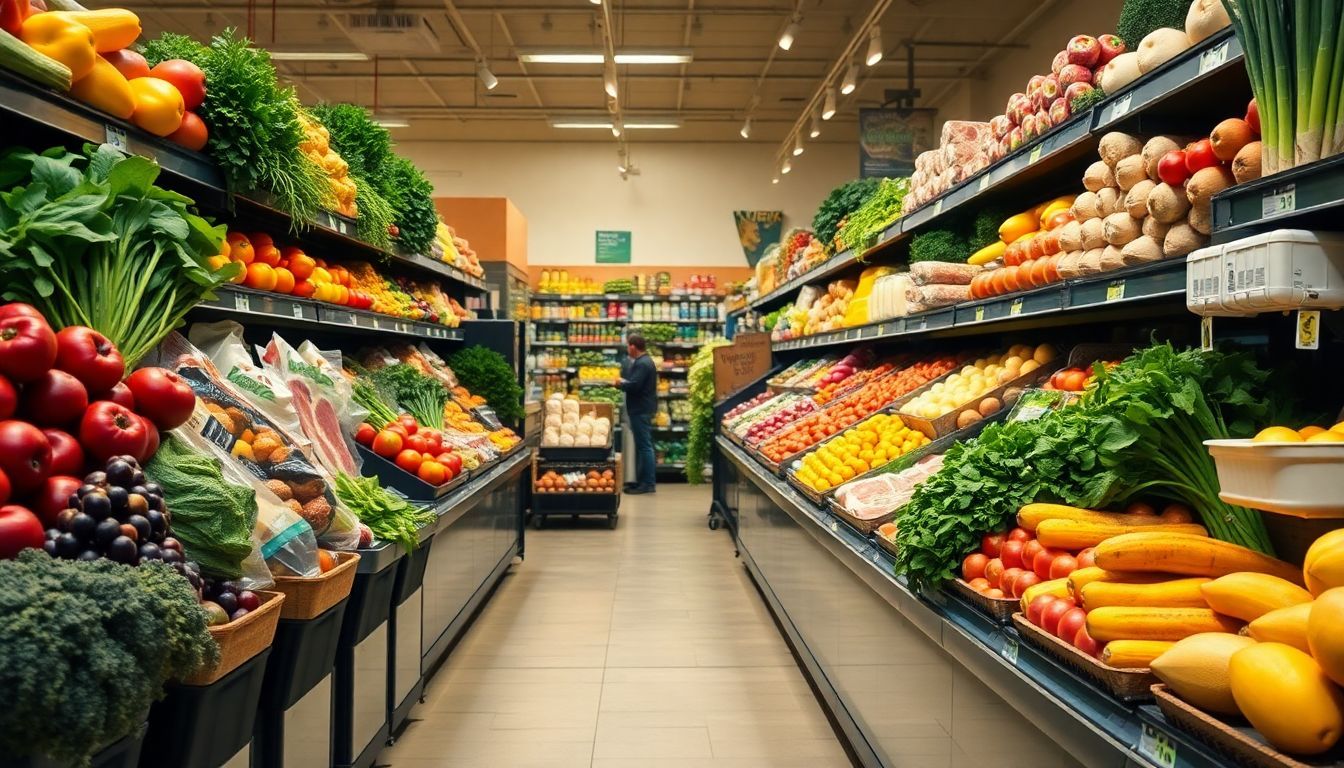Plan your meals ahead, and list all the healthy ingredients you’ll need—this saves time and keeps you focused on smarter choices.
Thank you for reading this post, don't forget to subscribe!Plan meals in advance
Weekly meal planning helps create a focused grocery list. This prevents impulse buys and saves money. A structured plan supports budgeting while encouraging healthier eating habits.
Studies show consistent use of lists improves dietary quality, linked to higher Healthy Eating Index (HEI) scores.
Prepare meals featuring whole grains, lean protein, and seasonal produce like sweet potatoes or leafy greens. Include items such as low-fat milk, frozen vegetables, or whole wheat bread for convenience and nutrition.
Planning also helps with weight management by promoting balanced meals over processed foods.
Include nutrient-rich staples
Stock up on whole grains like brown rice, quinoa, and whole wheat bread for energy-packed meals. These options are rich in fiber and keep you feeling full longer. Sweet potatoes also make a great addition—they’re loaded with vitamins A and C.
Choose lean protein sources such as skinless chicken or canned tuna for easy cooking. Mix things up with plant-based options like lentils, beans, chia seeds, or hemp seeds. Frozen vegetables and fruits are budget-friendly staples that preserve nutrients while cutting down trips to grocery stores.
A balanced diet starts with the right staples—stock your pantry wisely.
Shop the Perimeter of the Store

Stick to the store’s edges for fresh food like vegetables, lean meats, and dairy—this keeps your cart full of healthy picks!
Focus on fresh produce, dairy, and protein
Fresh produce, dairy products, and lean protein are key parts of healthy grocery shopping. Fill your cart with leafy greens like spinach or cruciferous vegetables such as broccoli.
Seasonal fruits like apples or zucchini offer fresh flavor and nutrients at lower prices. Choose low-fat milk, Greek yogurt, or plant-based milks for calcium-rich options.
Lean cuts of meat provide great protein sources—look for skinless chicken or turkey breast. Include canned tuna and low-sodium soups for quick meals. Eggs are budget-friendly and packed with protein too.
Stick to whole foods in the store’s perimeter to avoid processed items full of added sugars or saturated fat.
Avoid processed food aisles
Processed food aisles are full of less nutritious options. Packaged foods like chips, cookies, and instant meals often have added sugars, saturated fats, and high sodium levels. These can harm your health over time.
Stick to the store’s perimeter for fresh vegetables, fruits, lean meats, and dairy products like low-fat milk or Greek yogurt.
Healthy choices do exist in some middle aisles—like whole-grain crackers or canned tuna—but check nutrition facts labels carefully. Look for “no salt added” or “low-sodium” on items like tomato sauce or soups to reduce sodium intake.
Next up: how to read those labels more effectively!
Read Nutrition Labels Carefully
Check nutrition labels to spot hidden sugars, unhealthy fats, or too much salt—small steps lead to smarter choices.
Check for hidden sugars and sodium
Hidden sugars can sneak into foods like breakfast cereals, salad dressings, and flavored yogurt. Look for words like “cane sugar,” “corn syrup,” or “-ose” in the ingredient list. Even “healthy” options like protein bars may have added sugars.
The total daily limit of added sugar should be less than 50 grams for most adults.
Sodium hides in processed snacks, canned soups, and condiments such as hot sauce or tomato sauce. Aim to consume less than 2,300 mg of sodium daily (or 2,000 mg if following WHO guidelines).
Opt for items labeled “low-sodium” or “no salt added.” Always compare products—some brands use much more salt than others.
Small changes make a big impact—choose fresh over processed when possible.
Stay mindful while exploring seasonal produce to save money and eat healthier!
Compare products for healthier options
Not all products labeled “healthy” are good for you. Look closely at ingredient lists and serving sizes. Choose whole wheat bread over refined grains to add fiber. Swap white pasta for whole wheat pasta or one with added protein for better nutrients.
Compare items like canned tuna or soups by checking sodium levels. Opt for low-sodium broths instead of regular ones. Pick frozen vegetables without sauces to avoid extra saturated fat or added sugars.
Small changes like these can lead to smarter, healthier choices every time you shop!
Stay in the Sodium Safe Zone: How to Reduce Salt for Better Health
Too much salt can harm your health. The daily sodium limit is 2,300 mg in the U.S. or 2,000 mg by WHO guidelines. Avoid processed foods like snack foods and canned soups—they often hide high amounts of sodium.
Instead, pick low-sodium options such as low-sodium broths, fresh vegetables, and no salt added tomato sauce.
Use herbs and spices to add flavor instead of table salt. Garlic powder, paprika, or dried basil are great choices. Check nutrition labels carefully; aim for items with “low sodium,” meaning 140 mg or less per serving.
Gradually lower your salt intake—even small changes help train your taste buds over time! Fresh foods like lean cuts of meat or leafy greens naturally have little sodium too—making them healthier picks for meals.
Buy Seasonal and Local Produce
Seasonal fruits and vegetables are often fresher, tastier, and more affordable. Buying from local farmers helps you enjoy higher-quality produce while supporting your community.
Save money with in-season items
Buying in-season produce can save you money. Fruits and vegetables grown locally during their peak season often cost less to grow and transport. For example, fresh fruit like strawberries is cheaper in summer, while sweet potatoes are more affordable in fall.
Shopping this way also means getting the best flavor and quality since the items are fresher.
Check weekly sales or farmers’ markets for deals on seasonal fruits and vegetables. Stock up if prices drop but only buy what you can use before it spoils. Frozen vegetables or frozen fruits are great backups that last longer without losing nutrients.
This strategy stretches your budget while supporting a healthy diet full of fresh options!
Support local farmers
Seasonal produce from local farms is fresher and packed with nutrients. Local items like sweet potatoes, leafy greens, or seasonal fruits often taste better because they don’t travel far.
Farmers markets also offer unique finds like hot cereals, fresh vegetables, and low-fat dairy products.
Buying from local farmers boosts your community’s economy. Every dollar spent helps small businesses grow while supporting healthier food options for everyone. It promotes awareness of where your groceries come from—making meal planning more meaningful!
Be Strategic About Bulk Purchases
Bulk shopping can save both time and money if done wisely. Focus on shelf-stable items like whole-grain crackers or canned tuna to avoid waste.
Stock up on non-perishable healthy items
Canned beans, canned tuna, and low-sodium broths are great protein sources that last long. Whole grains like brown rice, quinoa, and whole wheat pasta are also perfect for your pantry.
They help you prepare healthy meals easily without worrying about spoilage.
Frozen fruits and vegetables work well as alternatives to fresh produce. Nuts, seeds like chia or hemp, and dried goods make convenient snacks full of nutrients. Store brands can often save money while still offering quality options for these items.
Avoid overbuying perishables
Buy perishable items in small amounts to avoid waste. Plan meals ahead and consider what you’ll actually use. For example, fresh fruits like bananas or leafy greens spoil quickly if not eaten on time.
Check expiration dates before adding items like low-fat milk or yogurt to your cart.
Frozen vegetables and frozen fruits are great alternatives for extending shelf life. Store leftovers properly or freeze them to make food last longer. Skinless chicken, turkey breasts, or lean cuts of meat can also be frozen if you don’t plan to cook them soon.
This way, nothing goes bad too fast!
Choose Whole Foods Over Processed Items
Pick foods in their natural form to fuel your body better. Whole options like fresh vegetables or lean protein support a more balanced diet.
Opt for whole grains and fresh ingredients
Whole grains like brown rice, oats, and whole wheat bread pack more fiber and nutrients than refined grains. Always check labels—make sure a whole grain is listed first in the ingredient list.
Swap white pasta for whole wheat pasta or sweet potatoes as side dishes. These small changes add vitamins and minerals to your meals.
Fresh ingredients make a big difference too. Stock up on leafy greens, fresh vegetables, and seasonal fruits. Fresh foods often have fewer added sugars and sodium compared to processed options.
Buy locally grown produce when possible—it supports farmers and ensures you get ripe, flavorful products!
Limit pre-packaged meals
Switching to fresh ingredients over pre-packaged meals supports better health. Pre-packaged foods often contain added sugars, unhealthy fats, and high sodium levels. These hidden additives can harm your body and raise risks for issues like heart disease or obesity.
Fresh vegetables, whole grains, and lean protein provide more nutrients without the harmful extras.
Cooking from scratch may take more time but offers control over what goes into your food. Replace ready-made pasta dishes with whole wheat pasta tossed in homemade tomato sauce or pesto.
Choose brown rice instead of boxed sides loaded with preservatives. Simple swaps like these help reduce processed foods while boosting essential nutrient intake!
Stick to Your Budget
Create a spending limit before heading to the store. Use price tags and deals to make every dollar count.
Use unit prices to find the best deals
Check the price per ounce, pound, or serving size on shelf labels. Many stores display unit prices to help compare costs. For example, salad dressing priced at $4.29 for 48 ounces is cheaper per ounce than one at $3.89 for 32 ounces.
Bigger packages often have a lower unit cost but may go bad if unused in time. Look beyond eye-level shelves—better deals might sit higher or lower. Avoid flashy end cap displays; they don’t always offer savings!
Avoid impulse purchases
Stick to a healthy grocery list. Planning meals helps you avoid buying items you don’t need. Write down only what’s necessary, like fresh vegetables, whole grains, lean meats, and low-fat dairy products.
Include “maybe” items if your budget allows it—like frozen fruits or extra protein sources.
Don’t shop hungry; this can lead to grabbing unhealthy snacks on impulse. If you’re tempted by processed foods or sugary treats not on your list, skip that aisle completely. This saves money and prevents regret later! Now let’s explore smarter ways to choose whole foods over processed ones….
Conclusion
Making healthier food choices doesn’t have to be hard. With a little planning and smart shopping, you can fill your cart with nutritious options. Focus on fresh produce, lean protein, and whole grains for balanced meals.
Read labels, shop wisely, and stick to what works best for your goals. Small steps in the store lead to better health over time!
For more detailed strategies on cutting back on salt, consider reading our article, How to Stay in the Sodium Safe Zone for Better Health.
References
- https://pmc.ncbi.nlm.nih.gov/articles/PMC4430323/
- https://www.trainerize.com/blog/healthy-eating-grocery-list/
- https://www.healthline.com/nutrition/healthy-grocery-shopping-guide
- https://www.webmd.com/food-recipes/grocery-list
- https://www.shelleyrael.com/blog/grocery-store-rule-shop-the-perimeter (2024-03-19)
- https://www.cdc.gov/diabetes/healthy-eating/spotting-hidden-sugars-in-everyday-foods.html (2024-06-17)
- https://www.heart.org/en/healthy-living/healthy-eating/cooking-skills/shopping/5-easy-ways-to-find-healthier-options-at-the-grocery-store
- https://www.mayoclinic.org/healthy-lifestyle/nutrition-and-healthy-eating/in-depth/sodium/art-20045479 (2023-06-28)
- https://www.nhlbi.nih.gov/news/2023/halt-salt-5-ways-cut-down-sodium-and-improve-your-heart-health (2023-02-13)
- https://www.myplate.gov/eat-healthy/healthy-eating-budget/shop-smart
- https://www.calicoandtwine.com/blog/how-to-shop-seasonally (2022-07-18)
- https://pmc.ncbi.nlm.nih.gov/articles/PMC6309636/
- https://nourishedbynic.com/guide-to-a-budget-friendly-healthy-grocery-haul/ (2024-04-20)
- https://www.buzzfeed.com/rossyoder/six-to-one-grocery-method-explained-i-tried
- https://www.heart.org/en/healthy-living/healthy-eating/cooking-skills/shopping/grocery-shopping-tips (2024-06-10)
- https://pmc.ncbi.nlm.nih.gov/articles/PMC8826838/
- https://www.verywellfit.com/what-is-a-whole-foods-diet-2241974 (2024-05-30)
- https://pmc.ncbi.nlm.nih.gov/articles/PMC4509783/
- https://reallifegoodfood.umn.edu/shop-smart/unit-pricing
